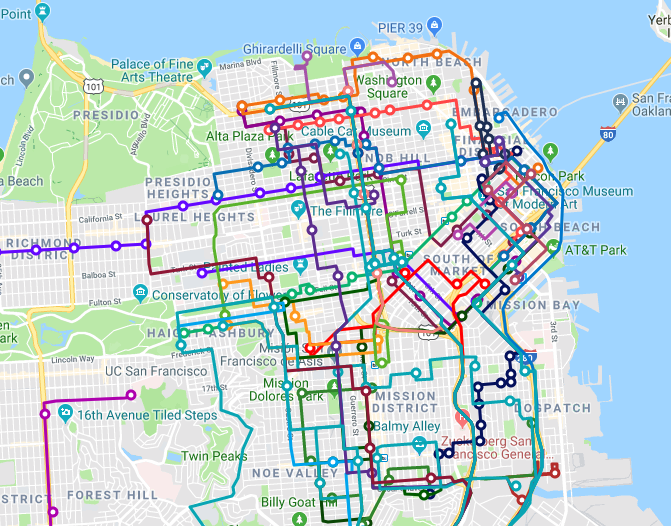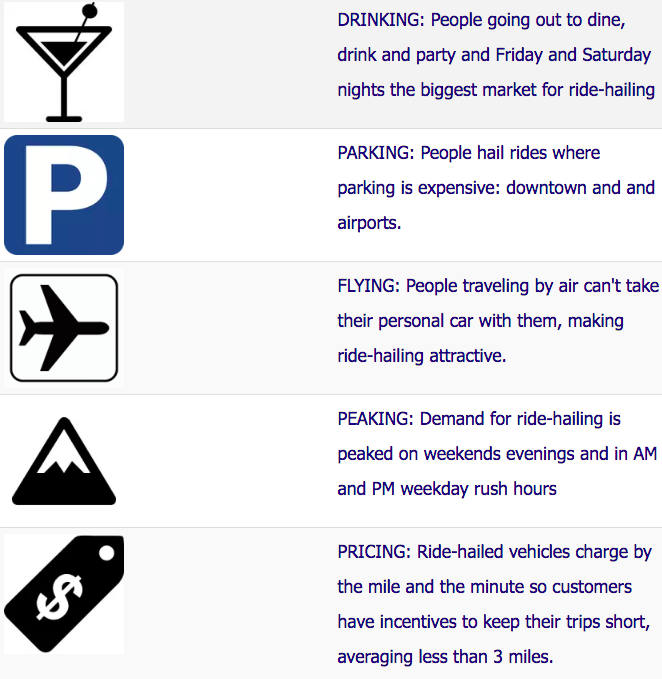What City Observatory did this week
Drinking, Parking, Flying, Peaking, Pricing: The five drivers of ride-hailing demand. The Transportation Research Board has published a dense, 100 page study of ride-hailing demand, drawing on survey and trip-making data from five cities around the country. There’s a lot to digest here, but fear not: City Observatory has distilled the report down into five key findings.
The emperor’s new infrastructure plan. Very few people seem to think that the Trump Administration’s infrastructure plan is a good idea, with various reviewers labeling it a fiction, a scam, or worse. Even the usually quite reserved Brookings Institution writes that it has “too much cynicism and too little leadership.” While there’s a lot not to like here, the one thing it shouldn’t be is a surprise: Coming from a real-estate wheeler-dealer with a very checkered business record, its hardly surprising that the plan consists mostly of boosting the Trump brand, financing deals with other people’s money, and–copious use of adjectives aside–being opaque about the likelihood and timing of any actual return on investment. Trumpfrastructure has an uncanny resemblance to Trump steaks, Trump University and Trump’s Atlantic City Casino: good promotion for him, and bad deal for almost everyone else involved. The best that can be said at this point is that it’s unlikely to move forward.
Must read
Does “microtransit” make sense? Jarrett Walker, never shy about asking hard questions about the sensibility of supposedly transformational technology solutions to urban transportation problems (witness his epic twitter duel with Elon Musk), now challenges those who are calling microtransit a new thing to put their cards on the table. In Walker’s view, microtransit consists of three elements, smaller vehicles, dispatched on varying routes to individual rider-selected origins and destinations, and some sort of web-enabled dispatching, routing and payment. The first two elements are well understood, Walker argues, noting that the economics have never proven out (services seldom manage to generate more than one rider per driver hour). As to wrapping dial-a-ride services in “app” clothing, he points out that’s something that good transit agencies are already working on. Even with automation, microtransit is inherently less efficient than fixed route transit (measured by rides per service hour), and subsidizing it, in Walker’s view, tends to promote inequality, because those who stand to benefit most from micro-transit have higher incomes.
Growing evidence that Portland’s inclusionary zoning law is choking off new apartment construction. The Oregonian’s Eliot Njus takes a close look at the dwindling pipeline of new apartment projects over the past year. Since the city’s inclusionary zoning requirements kicked in last February, the number of new apartment permits filed has dropped from around 4,000 to 6,000 annually to about 650. The law is likely to produce just 89 new “inclusionary” apartments as a result of permits filed this year. Portland’s recent apartment growth has been fueled by an influx of out-of-state capital, but given the uncertainty and costs associated with the IZ program, these investors are looking elsewhere: if institutional investors can’t get their desired return in Portland, they can build in other growing cities where they can. One ominous sign: no new apartment proposals is the city’s (until recently) booming downtown. The big danger here is that housing, especially apartments, tend to get built in boom periods; if Portland’s IZ law causes us to miss this boom, it likely means tighter supply and less affordability in the future.
New knowledge
While most transit service is operated by public entities, there are a growing number of private transit operators. Colleges and employers frequently operate transit systems to make their locations more accessible to students and/or employees. Private carriers often also provide transit services to and from airports. A growing number of private firms are attempting to compete in the urban line-haul market, like Chariot (a subsidiary of Ford) which provides transit services in San Francisco.

A new report from the Transportation Research Board catalogs the various kinds of private transit operations, and sketches out the policy issues likely to influence the industry’s growth in the years ahead. National Academies of Sciences, Engineering, and Medicine. 2018. Private Transit: Existing Services and Emerging Directions. Washington, DC: The National Academies Press. https://doi.org/10.17226/25020.
In the news
Bruce Katz and Jeremy Nowak responded to our critical review of their book the New Localism. We urge you to read their essay at CityLab and also have a look at our original take on their book. Bottom line: in ordinary times, cities are well-advised to simply ignore the federal government at go their own way. But these aren’t ordinary times, and the ongoing evisceration of the federal government is going to make cities jobs much, much more difficult.
American’s say they love diversity: They live it, too. Bloomberg View’s Noah Smith presented the findings of a study by Kwan Ok Lee, looking at the persistence of integrated neighborhoods. He references our article on the study, broadly agreeing with Lee’s point showing that once integrated, neighborhoods tend to stay that way. The US is not only more diverse, but more integrated. White flight has declined sharply, and its a hopeful sign, says Smith, that once Americans move to a mixed-race neighborhood, they tend to either stay there, or move to another mixed neighborhood.
Michigan Future’s Lou Glazer thinks there’s an important message in Amazon’s decision to leave both Detroit and Grand Rapids off its list of finalists for HQ2: building communities that attract and retain smart workers is the key to success, and Amazon doesn’t think Michigan is competitive yet. Glazer’s Grand Rapids Business Journal op-ed cites our City Observatory calculations on the talent dividend, showing the strong relationship between four-year degree attainment and per capita income, as well as our work studying the migration of the young and restless.


